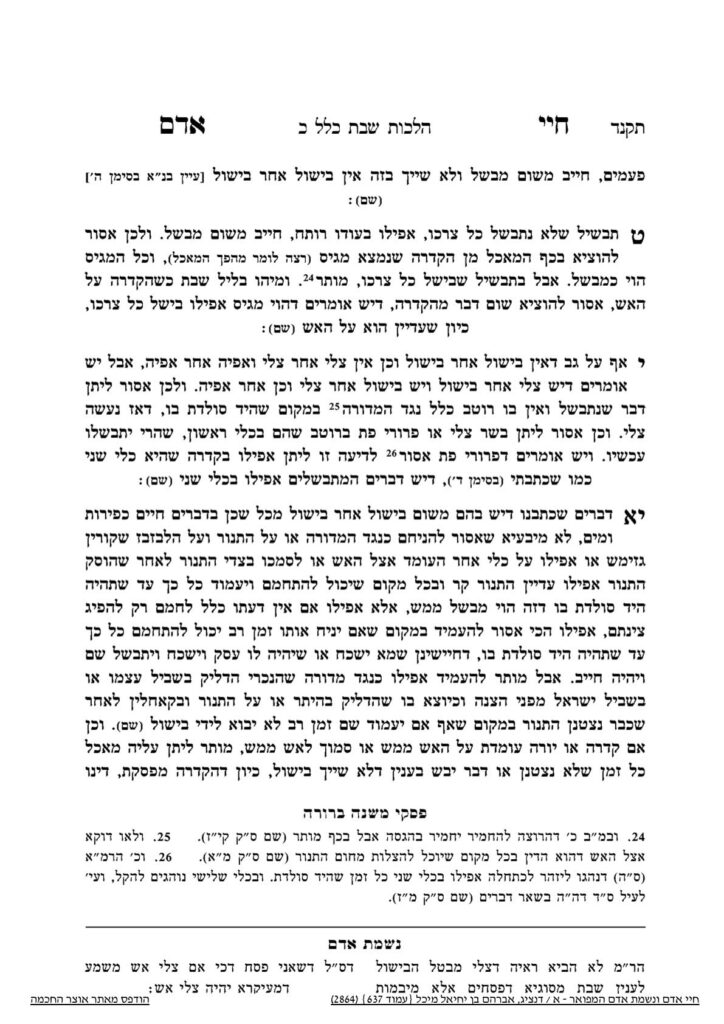We are continuing in siman 11, and we will continue our introduction to this part of the siman. We learned yesterday that nesinah lechatchilla is assur. But the Chayei Adam discussed scenarios where it is muttar to perform nesinah lechatchilla. We learned two scenarios yesterday, which were that the food is placed keneged hamadurah, or that the food was placed on top of another pot of food. Today, we will learn a third scenario. Although the previous two scenarios are universally accepted by the poskim, this third scenario is less accepted.
The Chayei Adam writes that another scenario where nesinah lechatchilla is muttar would be to place the food on top of an empty pot, known as kedeirah reikanis. Putting the food inside of the pot would clearly be assur, as it would constitute placing the food directly on the fire. Over here, the person is going to place an empty pot on top of the fire, and then place the food on top of the empty pot.
If the argument for heter in the first two scenarios is based on the abnormality of the placement, the argument is that there is a hekker (reminder that only this scenario is muttar and not to confuse this scenario with scenarios of issur) in these scenarios. If so, one could make the argument that placing food on top of an empty pot is strange as well, and this hekker should be no different than the other two scenarios.
However, the Mishnah Berurah understands that an empty pot on top of a fire can only be used for chazarah, not nesinah lechatchillah. For example, if one’s cholent is beginning to dry out, one could lift up the cholent and insert an empty pot underneath the cholent pot in order to minimize the heat, because they are fulfilling the conditions for chazarah. The Chayei Adam is understanding that the empty pot can be used even for nesinah lechatchillah, meaning, one could even put the empty pot and food on the fire for the first time on Shabbos.
The Chayei Arichei, a contemporary peirush on the Chayei Adam, explains the difference between the Chayei Adam and Mishnah Berurah. He explains that the Mishnah Berurah understands that the empty pot makes the food garuf v’katum. In the times of Chazal, garuf meant removing the coals, and katum meant covering the coals with ash. An empty pot approximates this idea, much in the way that our contemporary blech approximates this idea. If so, we know that the state of garuf v’katum can permit chazarah, but it can never permit nesinah lechatchillah. However, the Chayei Adam understands that the empty pot is similar to placing a food keneged hamadurah. Since it is not a normal place to cook, there is a hekker, and there is no concern that a person will perform nesinah lechatchilla.
Practically, the poskim follow the Mishnah Berurah, so using an empty pot will only be muttar for chazarah, and not for nesinah lechatchillah.
Summary
Nesinah lechatchilla is assur on Shabbos, even if the fire is garuf v’katum. Nevertheless, according to the Chayei Adam, there are three scenarios in which nesinah lechatchillah will be muttar, due to the hekker inherent in the placement of the food:
- When the food is placed keneged hamadurah, further away from the fire;
- When the food is placed on top of another pot which is full of food;
- When the food is placed on top of an empty pot. However, the poskim do not accept this third scenario.



